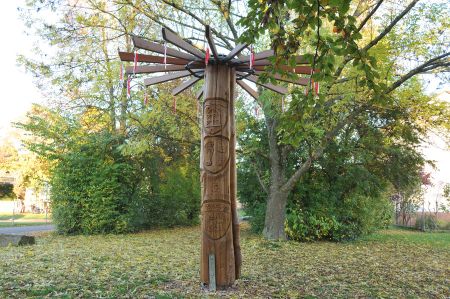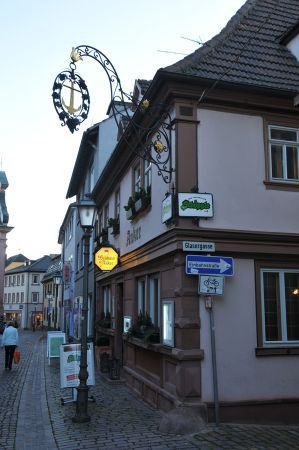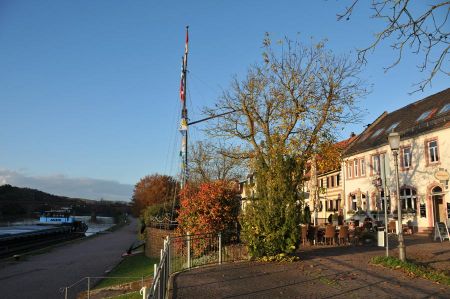Two appointments prompted us to travel to Marktheidenfeld, the town where the German Association for the Environment and Nature Conservation was founded in 1975.
Since we were still on our way to appointments in Schweinfurt in the morning, we now drove on the B26 to Thüngen, then on the scenically beautiful route that meanders along the foot of the Spessart via Birkenfeld to Marktheidenfeld.
Influx of large numbers of displaced persons
 After the end of our first appointment, we had enough time to take a short tour of the town, which was officially named Stadt Marktheidenfeld for the first time in 1397. The town was probably created in the first half of the 8th century during the Frankish conquest. As was usual at the time, around 855 the place belonged to the Holzkirchen monastery, which in turn belonged to the Fulda Abbey. In the years between 1522 and 1530, the Reformation was introduced in the County of Wertheim and thus also in Marktheidenfeld. Under the leadership of the pastor Johannes Molitor, the Counter-Reformation began in 1612 after Heidenfeld was confiscated as a Würzburg fief after the feud between Würzburg and Wertheim (1599 - 1617). After the passage of the initially victorious Swedes, the place became Protestant again for a short time between 1632 and 1634. Along with Würzburg, Marktheidenfeld also fell to Bavaria as a result of the border settlement agreement of 1804. The influx of large numbers of expellees caused Marktheidenfeld to grow steadily after the Second World War, so that the place was elevated to the status of a town on April 8, 1948.
After the end of our first appointment, we had enough time to take a short tour of the town, which was officially named Stadt Marktheidenfeld for the first time in 1397. The town was probably created in the first half of the 8th century during the Frankish conquest. As was usual at the time, around 855 the place belonged to the Holzkirchen monastery, which in turn belonged to the Fulda Abbey. In the years between 1522 and 1530, the Reformation was introduced in the County of Wertheim and thus also in Marktheidenfeld. Under the leadership of the pastor Johannes Molitor, the Counter-Reformation began in 1612 after Heidenfeld was confiscated as a Würzburg fief after the feud between Würzburg and Wertheim (1599 - 1617). After the passage of the initially victorious Swedes, the place became Protestant again for a short time between 1632 and 1634. Along with Würzburg, Marktheidenfeld also fell to Bavaria as a result of the border settlement agreement of 1804. The influx of large numbers of expellees caused Marktheidenfeld to grow steadily after the Second World War, so that the place was elevated to the status of a town on April 8, 1948.
The Franck house from 1745
 After parking the vehicle in the large car park on Ludwigstrasse, we began our tour of Bronnbacherstrasse. In addition to the large number of historic half-timbered houses, the wonderful Main Promenade, the market square with the Fischerbrunnen, the old town offers a large number of sights, including the St. Laurentius Church.
After parking the vehicle in the large car park on Ludwigstrasse, we began our tour of Bronnbacherstrasse. In addition to the large number of historic half-timbered houses, the wonderful Main Promenade, the market square with the Fischerbrunnen, the old town offers a large number of sights, including the St. Laurentius Church.
A little later we passed what is probably the most important sight in the city, the Franck House from 1745. The wine merchant and merchant Franz Valentin Franck had the richly decorated baroque building built by widening two existing half-timbered houses and connecting them with a gate building read. A large inner courtyard was created, the adjacent buildings of which then served as wine offices. In addition to some apartments on the first floor, there was also a ballroom. The so-called Red Salon is also characterized by rich stucco work.
A sandstone Maria Immaculata
On the façade, under a stucco canopy supported by angels, stands a sandstone Maria Immaculata. She holds a gilded lily sceptre in her right hand and crushes the serpent, the symbol of original sin. The wedge stones of the windows in the basement bear the four continents to the left of the portal and the four seasons to the right of the portal. On the capitals on the archway there are two lions with shields, which document the year of construction 1745 and the initials of the client - FVF. During the restoration, the smalt blue colour of the facade, the most expensive colour at the time of construction, was restored. From the courtyard you can access the old wine cellar (dated 1620) with large wine casks, which is more than a century older than the Franck house.
Today the house is used for exhibitions. Permanent exhibitions are the "smallest library in the world", a collection of small writing works from Valentin Kaufmann's estate, the show smithy, an old blacksmith's workshop set up in the courtyard, and an information room on the life and work of the painter and craftsman Hermann Gradl.
21 German environmentalists in Marktheidenfeld
On July 20, 1975, 21 German environmentalists met in Marktheidenfeld, including Bodo Manstein (1st Chairman), Horst Stern, Bernhard Grzimek, Hubert Weinzierl, Gerhard Thielcke, Herbert Gruhl, Hubert Weiger and Enoch zu Guttenberg, to found the association Bund für Nature and environmental protection Germany, BUND for short. With around 464,000 members, the association, which is recognized by the state as an environmental and nature conservation association, is one of the largest environmental associations in Germany. It has to be heard by the federal government in the event of interventions in the natural balance and has the right to take collective action under the Environmental Appeals Act. The association is financed by donations and is also supported by numerous sponsors.
Preservation of peatlands, for mobilization against nuclear power
For years, the BUND has seen itself in the role of a critical admonisher and observer who uncovers environmental policy deficits, does political lobbying and enlightens the public. He asks, for example, how renewable energies can be expanded, how rivers and lakes can be protected from pollutants, how radiation exposure can be reduced and how nature conservation can be promoted. Actions and campaigns at regional, national and international level led to the preservation of moor areas, mobilization against nuclear power and the promotion of environmentally friendly and healthy products. Tasks and functions that certainly serve the public good.
Rowing company Marktheidenfeld organizes the Red Dragon Cup every year
The path along the Main promenade also lets us come across some boats bobbing in the water, which arouse our photographic interest. Reason enough for a passer-by to approach us and refer to a special event in July every year. Since 1999, the Marktheidenfeld rowing company has organized the Red Dragon Cup every year. Company and club teams start in dragon boat races, in which the costumes of the participants are also awarded. A certainly spectacular event, which one could attend in the coming year.
Please read as well:
Sinkholes - Red and Blue Lake next to Imotski
Aunt Margherita Gabrielli - Meeting in Clauiano


